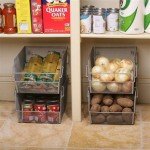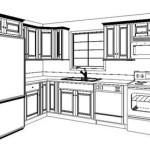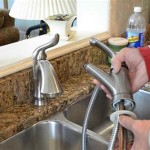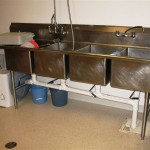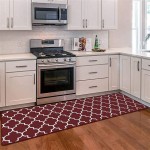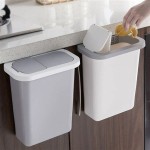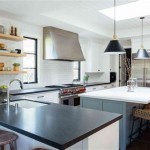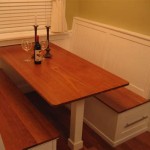Can You Mix Knobs and Pulls in a Kitchen Island Design?
The question of whether to mix knobs and pulls on a kitchen island is a common one during kitchen renovations or new construction. There is no definitive right or wrong answer, as the decision ultimately rests on aesthetic preferences and functional considerations. However, understanding the guidelines and potential advantages and disadvantages of mixing hardware types can help homeowners and designers make informed choices that enhance the overall look and usability of the kitchen.
Historically, kitchen design often adhered to strict rules regarding hardware consistency. Maintaining uniformity throughout the kitchen, including the island, was seen as a hallmark of good design. This approach provided a sense of order and visual cohesion. However, contemporary design trends embrace more eclectic and personalized styles, leading to greater flexibility in hardware selection.
The kitchen island has evolved from a simple workspace to a central hub for cooking, dining, and socializing. This multifunctional role necessitates careful consideration of all design elements, including the cabinet hardware. The decision to mix knobs and pulls on the island should therefore be viewed as an opportunity to enhance both the island's functionality and its visual appeal.
Understanding the Functionality of Knobs and Pulls
Knobs are typically smaller and more discreet than pulls. They are generally used for cabinet doors and smaller drawers, where a single point of contact is sufficient for opening and closing. Knobs often have a minimalist design and can be a cost-effective option, especially when outfitting a large number of cabinets.
Pulls, on the other hand, are longer and offer a more substantial grip. They are often preferred for larger drawers, such as those used for pots, pans, or utensils, as they provide greater leverage and make it easier to open heavily loaded drawers. Pulls also come in a wider variety of styles, ranging from sleek and modern to ornate and traditional.
When considering mixing knobs and pulls on a kitchen island, the primary factor should be the intended use of each cabinet or drawer. Drawers that will house heavy items or that are frequently used may benefit from the added leverage of pulls. Cabinets used for less frequently accessed items or purely for storage may be adequately served by knobs.
Beyond pure functionality, ergonomics also play a role. Individuals with arthritis or limited hand strength may find pulls easier to grip and use. Ensuring accessibility and ease of use for all members of the household is an important consideration in hardware selection.
Aesthetic Considerations in Mixing Hardware Types
While functionality is paramount, the aesthetic impact of mixing knobs and pulls cannot be ignored. A well-executed combination can add visual interest and personality to the kitchen island. However, a poorly planned mix can result in a disjointed and unappealing look.
One approach is to use knobs on all upper cabinets and pulls on all lower cabinets, including those on the island. This creates a consistent visual flow throughout the kitchen while still differentiating between the upper and lower zones. This separation can be further emphasized by selecting different finishes for the knobs and pulls, such as brushed nickel knobs and matte black pulls.
Another approach is to use knobs on cabinet doors and pulls on drawers. This strategy aligns with the functional considerations discussed earlier, as pulls are typically better suited for drawers. However, careful attention must be paid to the style and finish of the knobs and pulls to ensure they complement each other.
When mixing hardware types, it is crucial to maintain a cohesive design aesthetic. Choose knobs and pulls that share a common design element, such as a similar shape, finish, or style. For instance, pairing sleek, minimalist knobs with equally sleek, minimalist pulls can create a modern and sophisticated look. Conversely, pairing ornate, vintage-inspired knobs with matching vintage-style pulls can create a charming and traditional feel.
It is also important to consider the overall style of the kitchen. A modern kitchen may benefit from clean lines and minimalist hardware, while a traditional kitchen may call for more elaborate and decorative options. The hardware should complement the cabinets, countertops, and other design elements in the kitchen.
Strategies for a Successful Combination of Knobs and Pulls
Achieving a harmonious mix of knobs and pulls requires careful planning and attention to detail. Several strategies can help ensure a successful outcome.
First, consider the scale and proportion of the hardware in relation to the cabinets and drawers. Knobs and pulls that are too small will look insignificant, while those that are too large will overpower the design. A general guideline is to choose hardware that is approximately one-third the width of the drawer or cabinet door.
Second, pay attention to the spacing of the pulls. Consistent spacing is crucial for creating a unified and balanced look. While the length of the pulls may vary, the distance between the mounting holes should be consistent. This will ensure that all pulls are installed at the same height and alignment on the cabinets and drawers.
Third, use a consistent finish throughout the kitchen. While mixing finishes can be a stylistic choice, it is generally safer to stick to a single finish, such as brushed nickel, polished chrome, or matte black. This will create a sense of visual unity and prevent the hardware from looking mismatched.
Fourth, consider using a template for drilling the holes for the hardware. This will ensure that the holes are drilled in the correct location and alignment, preventing errors and ensuring a professional-looking installation. Templates are readily available at hardware stores and online.
Fifth, carefully consider the placement of the hardware on the island. For drawers, the hardware is typically centered horizontally on the drawer front. For cabinets, the hardware is typically placed on the hinge side of the door, near the top or bottom corner. However, there are no hard and fast rules, and the placement can be adjusted to suit individual preferences and the overall design of the kitchen.
Sixth, before committing to a particular combination of knobs and pulls, it is helpful to create a visual mock-up. This can be done by attaching the hardware to a sample cabinet door or drawer and evaluating the overall look. This will allow you to see how the different hardware types complement each other and whether they fit with the overall design of the kitchen.
Seventh, consult with a kitchen designer or hardware specialist. These professionals have extensive experience in selecting and installing cabinet hardware and can provide valuable guidance and advice. They can help you choose the right hardware types, finishes, and sizes to create a cohesive and aesthetically pleasing look.
In addition to the above strategies, it is also important to consider the long-term maintenance of the hardware. Choose hardware that is durable and easy to clean. High-quality hardware will withstand daily use and will not tarnish or corrode over time. Regular cleaning with a mild soap and water will help keep the hardware looking its best.
Ultimately, the decision of whether to mix knobs and pulls on a kitchen island is a personal one. By carefully considering the functional and aesthetic factors outlined above, homeowners and designers can create a kitchen that is both beautiful and functional. The key is to approach the decision with a clear understanding of the design principles and to choose hardware that complements the overall style of the kitchen.
When implemented thoughtfully, mixing knobs and pulls on the kitchen island can be a unique and creative way to express individual style and enhance the overall design of the kitchen. It allows for a more nuanced and personalized approach to hardware selection, moving beyond the traditional constraints of uniformity.
By balancing practical needs with aesthetic preferences, homeowners can create a kitchen island that is not only a functional workspace but also a visual focal point that reflects their personal taste and elevates the overall design of the kitchen.

How To Mix And Match Cabinet Hardware Sprucing Up Mamahood

How To Mix And Match Cabinet Hardware Sprucing Up Mamahood

How To Mix Kitchen Cabinet Hardware Knobs And Pulls Porch Daydreamer

How To Create A Custom Looking Kitchen Mixing Hardware Styles

How To Mix Kitchen Cabinet Hardware Decor

3 Quick Tips For Mixing Knobs Pulls On Kitchen Cabinets

How To Create A Custom Looking Kitchen Mixing Hardware Styles

Mixing And Matching Knobs Pulls On Kitchen Hardware Van Dyke S Rers

How To Mix Kitchen Cabinet Hardware Knobs And Pulls Porch Daydreamer

How To Create A Custom Looking Kitchen Mixing Hardware Styles
Related Posts

